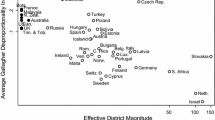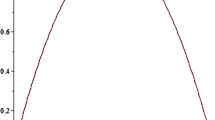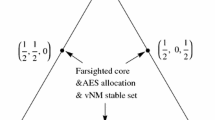Abstract
According to commonsense wisdom, under proportionality a small centrist party enjoys an excess of power with reference to its share of seats (or votes) due to the possibility of blackmailing the larger ones. This hypothesis has been challenged on a theoretical ground, with some empirical support. In this paper we use simulation to test its validity. Our results strongly provide evidence that the hypothesis is actually wrong. What occurs is a transfer of power from the periphery of the political spectrum towards the center, but the major gainers are the large centrist parties and not the small ones.
Similar content being viewed by others
Notes
For a broader description (actually, of a previous version) see Bissey and Ortona (2007). Some features employed here are detailed only in the readme file accompanying the program, downloadable from the site http://alex.unipmn.it/Ita/Alex_Software.php.
With reference to the real cases, the main changes are that we did not consider the geographical clustering of votes, and that we assumed a unique, nation-wide district (which is true only for The Netherlands).
The number of parties that obtained seats in the Parliament was very different in the two Italian polls, hence both cases are of interest.
Snyder et al. (2005, p. 993) find that the share of seats affects positively and strongly the power of a governing party.
For ALEX power index.
A contiguous coalition is a coalition of parties adjacent on the (assumed) left-right axis. In other terms, no “holes” are allowed in a majority coalition.
A party is pivotal (or crucial) when a coalition to which it belongs loses the majority if that party leaves it.
Mazurkiewicz and Mercik (2005) also suggested an index that takes into account the preference of the parties for the coalitions, based on a modified Shapley-Shubik index.
To be on the safe side, 3 coalitions difficult to classify due to the arbitrariness of the left-right axis have been supposed not contiguous.
For instance, the values corresponding to the third column of table 1 with b=0 resulted 0.0928 for A, 0.3503 for B, 0.1403 for C, 0.3096 for D and 0.1071 for E. Analogous results obtained for the other simulations.
These figures may differ slightly from the share of seats and across simulations also in pure proportionality, due to the random component of the simulation program—see the readme of the program ALEX 4.2, referred to in fn. 2.
The case of Germany is different, given the adoption of the 5 % threshold. However, in the only post-war poll without the threshold (1949) there were ate least 4 small centrist parties (the number varies according to the assumed location of the parties on the left-right axis).
We tried several distribution of seats among the three, without relevant changes; the following one may be considered representative.
For the real world cases we excluded some minor parties (with less than 1 % of votes and no seats); as a consequences our data may be slightly different from the official ones.
It must be emphasized that the hypothesis of contiguity of the coalitions may disturb the data, given the high number of small parties and their small dimensions.
The reduction of the number of parties, albeit ineffective in reducing the power rent, could be desirable as it reduces the transaction costs among the parties. This topic has been considered by Migheli and Ortona (2011); we will not discuss it here as it is out of the scope of this paper.
References
Aleskerov, F. (2006). Power indices taking into account agents’ preferences. In B. Simeone & F. Pukelsheim (Eds.), Mathematics and democracy (pp. 1–18). Berlin: Springer.
Alonso-Meijide, J. M., Alvares-Mozos, M., & Fiestras-Janeiro, M. G. (2009). The Banzhaf value when some players are incompatible. Homo Oeconomicus, 26(3/4), 403–414.
Bissey, M.-E., & Ortona, G. (2007). The program for the simulation of electoral systems ALEX4.1: what it does and how to use it. Università del Piemonte Orientale, Working paper POLIS n. 91. http://polis.unipmn.it.
Bomsdorf, E. (1982). In Holler (Ed.), The distribution of power in specific decision-making bodies.
Chessa, M., & Fragnelli, V. (2011). Embedding classical indices in the FP family. AUCO Czech Economic Review, 5, 289–305.
Gelman, A., Katz, J. N., & Bafumi, J. (2004). Standard voting power indexes do not work: an empirical analysis. British Journal of Political Science, 34, 657–674.
Felsenthal, D., & Machover, M. (1998). The measurement of voting power. Cheltenham: Elgar.
Felsenthal, D., & Machover, M. (2001). Myths and meanings of voting power: comments on a symposium. Journal of Theoretical Politics, 13, 81–97.
Fragnelli, V., Ottone, S., & Sattanino, R. (2009). A new family of power indices for voting games. Homo Oeconomicus, 26(3/4), 381–392.
Gambarelli, G. (1994). Power indices for political and financial decision making: a review. Annals of Operations Research, 51, 165–173.
International Institute for Democracy and Electoral Assistance (IDEA) (2005). Electoral system design: the new international idea handbook. Stockholm: IDEA.
Johnston, R. J. (2000). Power indices and the design of electoral/constitutional systems. Homo Oeconomicus, 17, 1–12.
Journal of Theoretical Politics (1999). Symposium on the Power Indices. 11(3), 291–366.
Leech, D. (2002). Voting power in the governance of the international monetary fund. Annals of Operations Research, 109, 375–397.
Leech, D., & Aziz, H. (2009). The double majority voting rule of the EU reform treaty as a democratic ideal for an enlarging union: an appraisal using voting power analysis. In W. Slomczynski & K. Zyczkowski (Eds.), Distribution of power and voting procedures in the European Union. Ashgate.
Mazurkiewicz, M., & Mercik, J. W. (2005). Modified Shapley–Shubik power index for parliamentary coalitions. Operations Research and Decision, 2, 43–52.
McGann, A., Ensch, J., & Moran, T. (2009). The surprisingly majoritarian nature of proportional democracy. Paper presented to the annual meeting of the American Political Science Association, Toronto, September 3–6.
Mercik, J. (1992). Voting procedure characteristics. Control and Cybernetics, 21(2), 207–215.
Merrill, S. (1984). A comparison of efficiency of multicandidate electoral systems. American Journal of Political Science, 28, 23–48.
Merrill, S. (1985). A statistical model for Condorcet efficiency based on simulation under spatial model assumptions. Public Choice, 47, 389–403.
Mielcová, E. (2010). The uncertainty in voting power: the case of the Czech Parliament 1996–2004. AUCO Czech Economic Review, 4, 201–222.
Migheli, M., & Ortona, G. (2011). Plurality, proportionality, governability and factions. Representation, 47(1), 99–113.
Nurmi, H. (1982). The problem of the right distribution of voting power. In M. J. Holler (Ed.), Power, voting and voting power (pp. 203–212). Wűrzburg: Physica-Verlag.
Nurmi, H. (2012, forthcoming). Some remarks on the concept of proportionality. Annals of Operations Research.
Nurmi, H., & Uusi-Heikkila, Y. (1985). Computer simulations of approval and plurality voting: the frequency of weak Pareto violations and Condorcet loser choices in impartial cultures. European Journal of Political Economy, 2, 47–59.
Snyder, J. M., Ting, M. M., & Ansolabehere, S. (2005). Legislative bargaining under weighted voting. The American Economic Review, 95(4), 981–1004.
Author information
Authors and Affiliations
Corresponding author
Rights and permissions
About this article
Cite this article
Migheli, M., Ortona, G. & Ponzano, F. Competition among parties and power: an empirical analysis. Ann Oper Res 215, 201–214 (2014). https://doi.org/10.1007/s10479-013-1390-8
Published:
Issue Date:
DOI: https://doi.org/10.1007/s10479-013-1390-8




